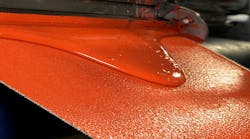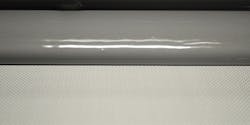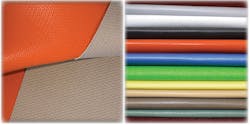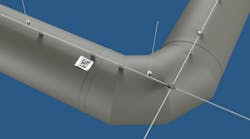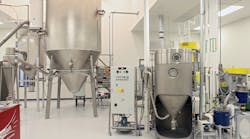Exploring the Safety of Solvents in Fabric Coating:
Download this article in .PDF format by clicking the download button below.
Commodity fabric coatings like polyvinyl chloride (PVC) and polyurethane (PU) are used in many different applications, but silicone-coated textiles have grown substantially in popularity over the years. Silicone-coated fabric is used in a range of industries including aerospace, aluminum, automotive, oil & gas, welding, and even food industry applications.
The composition of silicone fabrics largely determines performance, with configurations ranging from fabric-reinforced sheets to coated fabrics.
Comparison of Fabric Coating Manufacturing With Silicone Rubber
There are two types of coating fabric raw materials for cured silicone rubber on fabric: using high consistency silicone with a solvent, or 100% solid liquid silicone rubber and a catalyst. Solvents and high consistency rubber are used by many coaters as it is lower cost to use than 100% solids with catalyst.
However, using solvents in fabric coating poses environmental, health, and safety risks to personnel.
Risks With Solvents
One of the most common chemical health risks at places of work is exposure to solvents and other organic liquids. Most organic solvents are often highly volatile, combustible, and extremely flammable. Vapors produced by solvents can be heavier than air and can accumulate in confined places. This poses a safety risk as a spark from static electricity or welding, or smoking, may cause the vapors to explode.
Exposure to solvents, vapors, and mists poses many health risks as well. If the proper PPE is not used, fatigue, dizziness, and intoxication may be experienced. Exposure to high doses of solvents may lead to unconsciousness and/or death.
There are three types of solvents: oxygenated, hydrocarbon, and halogenated. Solvents that contain carbon and hydrogen only are hydrocarbon solvents such as gasoline, MEK, xylene, benzene, toluene, hexane, etc. Toluene is a very common solvent used in silicone rubber fabric coating in both U.S. companies and companies overseas.
Toluene (C6 H5 CH3 ) is a colorless liquid with a sweet, pungent odor. Workers exposed to toluene can have the health symptoms noted above as well as: eye and nose irritation, tiredness, confusion, tears, euphoria, headache, dilated pupils, anxiety, muscle fatigue, insomnia, nerve damage, inflammation of the skin, and liver & kidney damage.
The level of exposure to toluene depends upon the dose, duration, and work being done. Toluene is also a pollutant and can enter the environment through industrial emissions. Air toxics include volatile organic compounds (VOCs), polycyclic aromatic hydrocarbons (PAHs), aldehydes, and heavy metals. The most common air toxics? Benzene and Toluene.
As noted in the introduction, silicone-coated fabrics are often used in industrial processing environments such as aerospace, pertochem, chemical, power generation plants, ferrous/non-ferrous metals, and automotive. Solvents are not highly resistant to greases, fats, and oils, so solvent-coated fabrics may not hold up in these environments.
In a coating process using solvents, 100% of the solvents are not extracted which release over time, posing a health risk to those working with the fabric.
When to use 100% Solids Catalyzed Addition Curing
Coating with a 100% solids catalyzed addition curing system is recommended for all applications where the following apply:
- The safety and health risks to personnel are important
- The company is a good steward of the environment
- You need a fully cured (not B-stage) coated fabric
- No odor or flavor is produced (for food-contact applications)
- No volatile organic hydrocarbons are released
- Transparent articles do not discolor during post-curing
- Curing is fast and cycle times are therefore short
- The cured product has a non-blocking surface
A 100% solids catalyst system will cure quickly with heat, although they can also be formulated to cure at low temperatures and at room temperature. Silicone coating using a catalyst with curing is the preferred method of coating textiles with silicone. Solvents can be avoided, no by-products are generated, and the reaction is very fast.
Two-part systems do not release reaction by-products so they can cure in closed environments and their cure can be sped up by heat curing. In a production environment, coated fabrics can be given a fast, partial, or full heat cure through an oven to facilitate a quick setup of the silicone.
Silicone Coated Fabrics From Mid-Mountain Materials, Inc.
If you're looking for silicone-coated fabrics that don't use any solvents, Mid-Mountain is a great place to look.
ARMATEX Silicone Coated Fabrics are engineered for use in environments that need extreme heat or chemical resistance.
Some typical uses of these silicone-coated fabrics are:
- Engineered thermal barriers
- Protection from weld splatter
- Seals
- Smoke and sound barriers
- Robot covers
- Heat curtains and blankets
- Robot covers
- Removable pad insulation
If you would like to find out more about Mid-Mountain's coated fabrics, contact Mid-Mountain at [email protected] or call (206) 762-7600.
Download this article in .PDF format by clicking the download button below.
Mid-Mountain Materials, Inc. is an ISO 9001-2015 certified manufacturer of engineered thermal insulation barriers and seals that provide environmental protection, emissions control, and energy conservation.
